There Mercedes goes again, coming up with new ways to make cars safer: http://www.telegraph.co.uk/motoring/safety/5495705/External-airbag-slows-car-in-a-crash.html
You are using an out of date browser. It may not display this or other websites correctly.
You should upgrade or use an alternative browser.
You should upgrade or use an alternative browser.
External Airbags
- Thread starter chrisp
- Start date
More threads by chrisp
Here's an article I posted on the MB Club website this morning
Stuttgart-2009 is a year in which Mercedes-Benz celebrates several anniversaries in the safety field: in August 1939 the automotive safety pioneer Béla Barényi started his work at Mercedes-Benz in Sindelfingen. Regarded as the father of modern car safety, he invented a multitude of pioneering safety features. One example is the principle of the crumple zone, a trailblazing innovation which entered series production at Mercedes-Benz 50 years ago in 1959. With the help of its in-house accident research function, founded in 1969, Mercedes engineers in the following years have developed several groundbreaking innovations in passenger car safety. In this anniversary year, Mercedes-Benz is using the ESF 2009 research vehicle to reveal what its safety specialists are currently working on – with a time horizon that often extends well into the future.
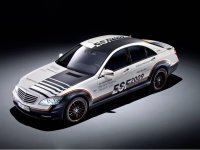
The ESF 2009 is the first Experimental Safety Vehicle to be built by Mercedes-Benz since 1974.
Like its historic predecessors, it illustrates trailblazing innovations in the field of safety and makes the progress achieved clearly visible. These amazing but by no means crazy ideas include inflatable metallic sections which give more stability to structural components within fractions of a second, as well as the so-called "Braking Bag". This airbag, housed within the vehicle’s floor, is deployed when a crash is deemed to be unavoidable, and uses a friction coating to support the vehicle against the road surface.
The ESF 2009 premiered yesterday, 15 June 2009, at the Enhanced Safety of Vehicles (ESV) Conference in Stuttgart.
"Safety is a central element of the Mercedes-Benz brand. In this respect we have been setting the pace in the market for almost 70 years for the benefit of our customers and for road users in general. The ESF 2009 shows that we still have plenty of ideas and the absolute will to lead the automobile industry in this field even in future", says Dr. Dieter Zetsche, Chairman of Daimler AG and CEO of Mercedes-Benz Cars.
The ESF 2009 was developed and built completely in the Mercedes-Benz test vehicle workshops in Sindelfingen.
This safety research vehicle, based on the Mercedes S 400 HYBRID, features more than a dozen safety innovations, most of which are fully functioning in demonstration mode.
"With the ESF 2009, we have chosen this particular time to clearly demonstrate the innovative strength of Daimler. Anybody examining the ESF 2009 in detail will recognise that more safety and improved energy efficiency are not necessarily a contradiction in terms. We want to make progress in both fields with new, trailblazing ideas ", says Dr. Thomas Weber, the member of the Daimler Executive Board responsible for corporate research and development at Mercedes-Benz Cars.
The following five innovations on the basis of the S 400 Hybrid are among the highlights of the ESF 2009:
PRE-SAFE Structure: The inflatable metal structures save weight or increase the stability of structural components. When at rest, the metal section is in a folded state to save space. If its protective effect is required, a gas generator builds up an internal pressure of 10 to 20 bar within fractions of a second, causing the section to unfold for significantly more stability.
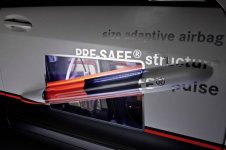
Braking Bag: This auxiliary brake accommodated in the vehicle floor is a new type of PRE-SAFE® component. If the sensor system concludes that an impact is unavoidable, the Braking Bag is deployed shortly before the crash and stabilises the car on the road surface by means of a friction coating. The vehicle's vertical acceleration increases the friction, and helps to decelerate the vehicle before the impact occurs.
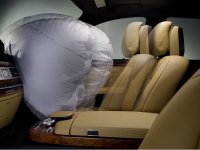
Interactive Vehicle Communication: The ESF 2009 is able to communicate directly with other vehicles, or via relay stations. Using "ad hoc" networks and WLAN radio technology, it is, for example, able to receive and transmit warnings of bad weather or obstacles in the road.
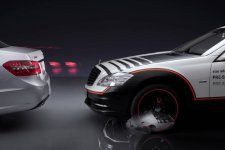
PRE-SAFE Pulse: This further development of PRE-SAFE® is able to reduce the forces acting on the torsos of the occupants during a lateral collision by around one third. It does this by moving them towards the centre of the vehicle by up to 50 millimetres as a precautionary measure. As an active restraint system, it uses the air chambers in the side bolsters of the seat backrests.
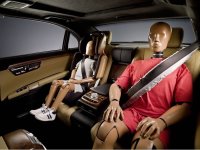
Spotlight lighting function: This partial LED main beam specifically illuminates potential hazards. If the infrared camera of Night View Assist PLUS detects, for example, deer at the roadside or pedestrians on the road, these can be briefly illuminated beyond the normal area covered by the main beams, as if by a spotlight.
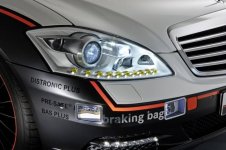
Mercedes-Benz is also presenting an innovative PRE-SAFE Demonstrator at the 21st ESV Conference. For the first time this simulator uses a linear motor for this purpose, in order to accelerate the vehicle cabin to up to 16 km/h within a distance of four metres before the impact occurs.
The linear drive system, which is similar to that used by the Transrapid train, is freely programmable and also works in the opposite direction. This enables various acceleration profiles and also a rear-end collision to be demonstrated.
The special feature of this system is that the 'vehicle occupants' experience the effect of the PRE-SAFE® functions live, such as seat belt pre-tensioning, NECK-PRO, and the inflatable side bolsters of the seats.
Mercedes-Benz is continuing a longstanding tradition with the ESF 2009: for the ESV Safety Conferences held in 1971 to 1975, the safety experts in Stuttgart built more than 30 experimental vehicles and subjected them to crash tests to satisfy the visionary safety requirements of that time.
Four of these ESFs (Experimental Safety Vehicles) were presented to the public, and many of the revolutionary ideas such as ABS or the airbag first entered series production at Mercedes-Benz.
Stuttgart-2009 is a year in which Mercedes-Benz celebrates several anniversaries in the safety field: in August 1939 the automotive safety pioneer Béla Barényi started his work at Mercedes-Benz in Sindelfingen. Regarded as the father of modern car safety, he invented a multitude of pioneering safety features. One example is the principle of the crumple zone, a trailblazing innovation which entered series production at Mercedes-Benz 50 years ago in 1959. With the help of its in-house accident research function, founded in 1969, Mercedes engineers in the following years have developed several groundbreaking innovations in passenger car safety. In this anniversary year, Mercedes-Benz is using the ESF 2009 research vehicle to reveal what its safety specialists are currently working on – with a time horizon that often extends well into the future.

The ESF 2009 is the first Experimental Safety Vehicle to be built by Mercedes-Benz since 1974.
Like its historic predecessors, it illustrates trailblazing innovations in the field of safety and makes the progress achieved clearly visible. These amazing but by no means crazy ideas include inflatable metallic sections which give more stability to structural components within fractions of a second, as well as the so-called "Braking Bag". This airbag, housed within the vehicle’s floor, is deployed when a crash is deemed to be unavoidable, and uses a friction coating to support the vehicle against the road surface.
The ESF 2009 premiered yesterday, 15 June 2009, at the Enhanced Safety of Vehicles (ESV) Conference in Stuttgart.
"Safety is a central element of the Mercedes-Benz brand. In this respect we have been setting the pace in the market for almost 70 years for the benefit of our customers and for road users in general. The ESF 2009 shows that we still have plenty of ideas and the absolute will to lead the automobile industry in this field even in future", says Dr. Dieter Zetsche, Chairman of Daimler AG and CEO of Mercedes-Benz Cars.
The ESF 2009 was developed and built completely in the Mercedes-Benz test vehicle workshops in Sindelfingen.
This safety research vehicle, based on the Mercedes S 400 HYBRID, features more than a dozen safety innovations, most of which are fully functioning in demonstration mode.
"With the ESF 2009, we have chosen this particular time to clearly demonstrate the innovative strength of Daimler. Anybody examining the ESF 2009 in detail will recognise that more safety and improved energy efficiency are not necessarily a contradiction in terms. We want to make progress in both fields with new, trailblazing ideas ", says Dr. Thomas Weber, the member of the Daimler Executive Board responsible for corporate research and development at Mercedes-Benz Cars.
The following five innovations on the basis of the S 400 Hybrid are among the highlights of the ESF 2009:
PRE-SAFE Structure: The inflatable metal structures save weight or increase the stability of structural components. When at rest, the metal section is in a folded state to save space. If its protective effect is required, a gas generator builds up an internal pressure of 10 to 20 bar within fractions of a second, causing the section to unfold for significantly more stability.

Braking Bag: This auxiliary brake accommodated in the vehicle floor is a new type of PRE-SAFE® component. If the sensor system concludes that an impact is unavoidable, the Braking Bag is deployed shortly before the crash and stabilises the car on the road surface by means of a friction coating. The vehicle's vertical acceleration increases the friction, and helps to decelerate the vehicle before the impact occurs.

Interactive Vehicle Communication: The ESF 2009 is able to communicate directly with other vehicles, or via relay stations. Using "ad hoc" networks and WLAN radio technology, it is, for example, able to receive and transmit warnings of bad weather or obstacles in the road.

PRE-SAFE Pulse: This further development of PRE-SAFE® is able to reduce the forces acting on the torsos of the occupants during a lateral collision by around one third. It does this by moving them towards the centre of the vehicle by up to 50 millimetres as a precautionary measure. As an active restraint system, it uses the air chambers in the side bolsters of the seat backrests.

Spotlight lighting function: This partial LED main beam specifically illuminates potential hazards. If the infrared camera of Night View Assist PLUS detects, for example, deer at the roadside or pedestrians on the road, these can be briefly illuminated beyond the normal area covered by the main beams, as if by a spotlight.

Mercedes-Benz is also presenting an innovative PRE-SAFE Demonstrator at the 21st ESV Conference. For the first time this simulator uses a linear motor for this purpose, in order to accelerate the vehicle cabin to up to 16 km/h within a distance of four metres before the impact occurs.
The linear drive system, which is similar to that used by the Transrapid train, is freely programmable and also works in the opposite direction. This enables various acceleration profiles and also a rear-end collision to be demonstrated.
The special feature of this system is that the 'vehicle occupants' experience the effect of the PRE-SAFE® functions live, such as seat belt pre-tensioning, NECK-PRO, and the inflatable side bolsters of the seats.
Mercedes-Benz is continuing a longstanding tradition with the ESF 2009: for the ESV Safety Conferences held in 1971 to 1975, the safety experts in Stuttgart built more than 30 experimental vehicles and subjected them to crash tests to satisfy the visionary safety requirements of that time.
Four of these ESFs (Experimental Safety Vehicles) were presented to the public, and many of the revolutionary ideas such as ABS or the airbag first entered series production at Mercedes-Benz.
OzBenzHead
Master
Very interesting, Chris and Michel.
Wasn't the 1974 ESV based on a W116?
If so, ESV 2009 is perhaps its immediate successor.
Wasn't the 1974 ESV based on a W116?
If so, ESV 2009 is perhaps its immediate successor.
Thanks to both of you for diiging up and elaborating on what will eventually develop into an important safety feature. As a matter of interest also, Michel, I looked up your post on the MBCNSW site and with surprise, saw quite a few 'development and news items' posts (press releases - simpler term ?) submitted by both yourself and Matthew.
I don't know how you feel, but there is almost no response nor acknowledgement forthcoming from the combined membership of that website. That sort of scenario I would find quite off-putting. Regards Styria
I don't know how you feel, but there is almost no response nor acknowledgement forthcoming from the combined membership of that website. That sort of scenario I would find quite off-putting. Regards Styria
